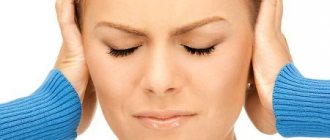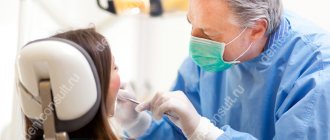This state cannot be called merely unpleasant or uncomfortable. Pulsating pain in a tooth can not only reduce a person’s quality of life - because of it, he may temporarily lose the ability to work normally, sleep, eat, etc. Dentists at the CrystalDent clinic urge all patients who are faced with this problem not to endure this condition in the expectation that it will go away on its own. The specialist strongly recommends immediately seeking help from a doctor and talks about the nature, causes, and methods of dealing with this problem.
Causes of throbbing tooth pain
It causes a feeling that at the site of its source someone or something is purposefully and monotonously hitting the nerve endings, tugging at them, causing them and the patient himself to shudder. This is approximately true, since it occurs due to mechanical irritation of a nerve bundle exposed for some reason, located in the soft tissues (pulp) of the tooth.
Throbbing pain can be either constant or occur periodically - when closing teeth, brushing them, touching them, eating, exposure to heat or cold, or any mechanical stress. It can last for several seconds or several hours, and in some cases it practically does not subside at all. In any case, this is a signal that urgent medical attention is required.
This, to put it mildly, unpleasant sensation may appear for the following reasons:
- Caries. This is one of the most common provocateurs of pain of this nature. When it occurs at an early stage, they can be almost imperceptible and short-lived. But as the problem progresses, they intensify, since the hard tissues that protect the pulp from external influences are gradually destroyed;
- Pulpitis. This pathology is a consequence of the destruction of hard dental tissues, which exposes the nerve of the tooth. Most often, this inflammatory process develops as a result of deep caries that has reached the final stages. With pulpitis, the patient feels severe throbbing pain in the tooth, which can radiate to the ear, temple, and even to the neck, eyes, and nose. It can make itself felt either periodically or not recede for a long time;
- Thinning, damage to tooth enamel. In such cases, a reaction of the nerve bundle to external stimuli is also possible;
- Mechanical damage to the tooth due to trauma. If, as a result of the latter, the hard tissues protecting the pulp are destroyed, it becomes exposed, and therefore reacts to any external influence;
- Periodontitis. This disease is an inflammatory process that occurs in the tissues around the apex of the tooth. In this case, the throbbing pain may intensify when touching not only the patient himself, but also the gum, which may also be inflamed;
- Periodontitis. With this pathology, inflammation develops in bone tissue, and, as a rule, this is a consequence of their infection;
- Incorrectly installed filling or insufficient treatment. Patients often complain that throbbing pain appears after filling, and in such cases the reasons may be different. For example, under a temporary filling it may appear due to the effect of a drug that kills the nerve that needs to be removed, and this option is normal. Once treatment is completed and a permanent filling is installed, this problem usually goes away. At the same time, during the treatment process, the doctor must be sure that pain is not a consequence of insufficient treatment. But there are also situations when throbbing pain appears even after the end of treatment. This may also be a variant of the norm - the injured tissues are still healing, and after a few days the discomfort will subside. If this does not happen, it is possible that the tooth was treated poorly (for example, the nerve was not completely removed or the pulp was injured by mechanical forces). It is also possible that a permanent filling is installed incorrectly, which literally puts pressure on the nerve bundle. In both of the latter cases, re-treatment and/or re-filling should be performed.
The problem can also appear after tooth extraction, and in some cases it signals infection of the hole that remains after it.
There are also situations when it is difficult for the patient to determine the localization of these sensations. To accurately establish it, sometimes an in-person examination by a doctor is not enough, but an x-ray will help do this.
Why does the tooth pulsate, but does not hurt?
If a person feels increased pulsation in the gum area, but does not feel pain, this indicates the following diseases :
- apical periodontitis . Pulsating sensations occur during exacerbation of the pathology. This occurs due to the accumulation of pus in the problem area. Mild pain can only be felt when pressing firmly on the affected area;
- periodontitis . As the disease progresses, inflammation of the tissues around the tooth occurs. This leads to the appearance of characteristic pulsating shocks without pain, since the sensations do not come from the affected pulp.
Periodontitis
Periodontitis
If it pulsates in the tooth area without pain, this may indicate inflammation of the cyst. Increased growth of the tumor occurs with sudden hypothermia of the body.
Reference! A slight pulsation without significant pain may occur after surgical treatment. However, if the procedure is successfully performed, such symptoms will disappear after 3-5 days.
First aid for throbbing tooth pain
These sensations are sometimes unbearable, and in order to calm them down a little, various painkillers are used.
The following medications can be used:
- Nonsteroidal anti-inflammatory drugs (NSAIDs). Such medications can relieve pain for several hours. In addition, they have anti-inflammatory effects. The most effective painkillers in this category are Ibuprofen, Ketanov, Ketorolac, Ketorol;
- Derivatives of phenylacetic acid. These drugs have not only analgesic, but also anti-inflammatory effects. Their most popular and effective representatives are “Aceclofenac”, “Diclofenac”;
- Such remedies as “Indomethacin”, “Nise” also help to temporarily eliminate throbbing toothache;
- If the sensations are not too pronounced, Paracetamol, Aspirin, and Analgin will help temporarily numb the tooth.
There are also folk remedies that help relieve pain for a short time:
- Ice. It is wrapped in cloth or gauze and applied to the cheek;
- Rinse with soda solution. To prepare it, 1 tsp. soda is dissolved in a glass of warm (but not hot) water, and the resulting composition is rinsed in the mouth. You can add a little iodine (a couple of drops) and salt to the solution;
- Rinse with sage decoction. It is prepared by pouring boiling water (1 cup) over the herb (0.5 tsp), and then sending the mixture to a steam bath for a third of an hour. When the broth has cooled (but it should not become cold), it is decanted and used for rinsing.
Using any methods of pain relief, first of all, you need to carefully clean the oral cavity and the diseased tooth itself from plaque, using toothpaste and a brush.
It is very important to consider the following points:
- The use of painkillers is not a treatment, but only a temporary elimination of symptoms to alleviate the patient’s condition before his visit to the dentist;
- The given examples of drugs and traditional methods are not universal and guaranteed to be effective. In some cases, using any of them can even be harmful. Be sure to contact your doctor to see what steps you can take to relieve your condition. Only a doctor can determine the means that will help do this in each specific case.
Some patients, feeling that the pain has subsided, believe that the problem has passed. This is a big misconception! Eliminating symptoms does not eliminate the disease, so a visit to the dentist is inevitable if you do not want to allow the pathology to rapidly progress and lead to more serious consequences.
Pain during caries, pulpitis and periodontitis -
In the absence of symptoms of teething and inflammation, pain can only be associated with some kind of dental disease, for example, it could be caries or pulpitis. Before starting treatment, it is necessary to generally decide on the advisability of maintaining it. After all, there are often situations when expensive treatment is carried out on a tooth that is of no value either from a functional point of view or from the point of view of the need to use the tooth in the future for prosthetics.
- Wisdom teeth caries – symptoms may include pain in response to sour, sweet foods, and cold irritants. Such pain goes away immediately after the irritant stops working. It is up to the dentist to decide whether to treat or remove such a tooth. This will depend on the correct position of the tooth, whether it is needed for prosthetics, etc. However, in some cases, determining the cause of pain (as well as the causative tooth) can be quite difficult.
For example, there are situations when an erupting wisdom tooth presses its crown onto the seventh tooth in front, causing its destruction. In this case, the carious lesion is located on the far surface of the seventh tooth near the gum or even just below it. This can usually be diagnosed using an x-ray. On the radiographs below, you can see carious lesions that look like intense darkening (indicated by arrows).
- Pulpitis of wisdom teeth – → with acute pulpitis, patients may experience acute, paroxysmal pain.
As a rule, pain is spontaneous, i.e. occur spontaneously, without any irritants. And if with caries the pain goes away immediately after the thermal irritant has been removed, then with pulpitis the pain does not go away even after the irritant is removed and can last about another 10-15 minutes. At night, the pain usually increases. → with chronic pulpitis of the wisdom tooth, the main symptom is also pain, but it will no longer be as pronounced. The pain will be aching and occur periodically. It can be provoked by cold and heat irritants. After eliminating the irritants, the pain does not go away immediately, but after 10-15 minutes. If your wisdom tooth is aching, then it is likely that this is a chronic form of pulpitis (24stoma.ru). - Periodontitis of the wisdom tooth – → with acute periodontitis, patients usually complain of aching pain, which is clearly localized in the wisdom tooth.
Biting on a tooth causes a sharp increase in pain. Swelling of the gums/cheeks may appear in the projection of the causative tooth. If your wisdom tooth hurts, your gums hurt, there is swelling of the gums near the tooth on the buccal or lingual side, then it is quite possible that this is an acute form of periodontitis. → with chronic periodontitis there are often no symptoms at all. Sometimes there may be painful biting on the tooth, as well as tapping on it. But the pain in this case is not very strong. There may be a fistula on the gum in the projection of the wisdom tooth, from which scanty purulent discharge will be released.
What remedies will not be effective?
In most cases, it is impossible to remove the pain syndrome associated with the development of inflammation with the help of rinses, ointments, and antibiotics. The main treatment here will be excision of the hood over the wisdom tooth. Self-medication, at best, will reduce symptoms for a certain period, but at worst, it will lead to complications. We hope that our article was useful to you!
Sources:
1. Higher prof. the author's education in surgical dentistry, 2. Based on personal experience as a dental surgeon, 3. National Library of Medicine (USA), 4. “Pathology of wisdom teeth eruption” (Rudenko A.), 5. “Qualified removal of third molars” ( Asanami S.).
Professional treatment
Its tactics and volume are determined by the doctor, and it depends on the causes of the problem and the condition of the diseased tooth. After an in-person examination, if necessary, the specialist sends the patient for an x-ray in order to accurately determine the location of the lesion and examine the condition of the root and dental tissues.
Based on a preliminary study, the following assistance can be provided to the patient:
- Treatment of caries;
- Depulpation of the tooth with treatment and subsequent filling of the dental canals;
- If its tissues are severely damaged, it may be necessary to install a crown or other types of prostheses (for example, veneers, lumineers);
- If the cause of the pain lies in a root disease, if possible, it is treated by opening the canals. It is possible that resection of its apex will be required to eliminate the source of inflammation and preserve the tooth;
- In some cases, it is not possible to avoid completely removing the latter.
If discomfort occurs after filling, and the reason lies in improper treatment, the filling is opened, the canals are treated, if necessary, and then the filling is repeated.
Diagnosis of toothache. Features of complications in the absence of treatment
The correct diagnosis can only be established after examining the oral cavity. The dentist must analyze complaints, obtain information about concomitant ailments, previous injuries and find out the nature of the pain. Then prescribe adequate treatment
A visual examination by a doctor may include the following manipulations:
- applying light tapping movements to the tooth to determine the location of the pathology;
- determining the reaction to exposure to heat;
- examination of the condition of the enamel using a special lamp or laser;
- study of the condition of dentures, if any;
- X-ray diagnostics to identify foci of inflammation, root fractures and other hidden problems;
- 3D computed tomogram, which allows you to obtain a three-dimensional model of an organ, view the internal structure of the bones, identifying neoplasms and cysts.
CT scan.
Network of dentists “Smile”, Shchelkovo Whatever the toothache is - severe, low-intensity, nagging, sharp, appeared today or has been lasting for several days - make an appointment with a dentist. Even if the pain has subsided and does not manifest itself at all, you cannot cancel the visit. Some insidious diseases (such as pulpitis) can behave changeably: after a sudden exacerbation, some relief may occur. However, you should not wait for the next attack or hope that the disease has gone away on its own and the pathological process has stopped.
Note! Before visiting the dentist, do not take medications that relieve pain - analgesics (tablets, injections). This will blur the symptoms, and it will be difficult for the doctor to make a diagnosis, not to mention the correct treatment regimen, due to the dulling of symptoms by painkillers.
Prevention
No one is immune from diseases and the discomfort associated with them, but measures can be taken to reduce the risk of encountering them. In the case of dental problems, including throbbing pain in the tooth, they are as follows:
- Inspect your mouth regularly to detect early caries early. If you notice it, contact your doctor immediately to get it eliminated as quickly as possible. At the initial stages of its development, it is possible not only to preserve the tooth, but also the nerve in it, which means that it will remain “alive” and will last for many years;
- Regularly visit the dentist - he will see with a professional eye possible problems that the patient himself did not notice, and immediately begin treatment;
- Strictly adhere to the rules of oral hygiene - you need to brush your teeth twice a day, doing it thoroughly and for at least 2-3 minutes. After eating, use dental floss and special rinses;
- Don't skip professional oral cleaning. With its help, it is possible to remove plaque that a regular toothbrush cannot cope with. It often becomes the cause of the development of caries, other dental problems and all their negative consequences;
- As soon as pain makes itself felt, do not delay in seeing a doctor. They are always a “bell” that a pathology is developing, but it will not go away on its own, and without the help of a specialist it will only get worse.
The dentists of the CrystalDent clinic draw the attention of patients to the fact that it is very important to find an experienced, responsible doctor who can provide professional assistance to the required extent, and not only quickly relieve pain, but also save the tooth, do everything to ensure that it served for many more years.
Kostyuk Anna Vladimirovna
Orthopedic dentist of the first category
Did you like the article?
Rate: (no rating)
Loading…
What to do if a wisdom tooth interferes with normal life
Modern dentistry initially suggests using painkillers, for example, Ibuprofen or Analgin, to relieve severe pain. Further, if it does not subside, you need to immediately contact a specialist. He will study the nature of the unpleasant sensations, evaluate the position of the “eight” and its role in the future (possibility of use for prosthetics). If it is unhealthy, then in 70-80% of cases the patient will be recommended to remove the wisdom tooth. This is due to difficult access to it. They also resort to its removal when it does not erupt for a long time and interferes with other molars.
A wisdom tooth causes a lot of trouble for its owner, and if you are faced with it, it’s time to visit an experienced dentist. Believe me, the problem will not be solved by itself! The specialists of the Kariesu.net clinic will quickly and reliably relieve you of pain and restore the joy of life.









